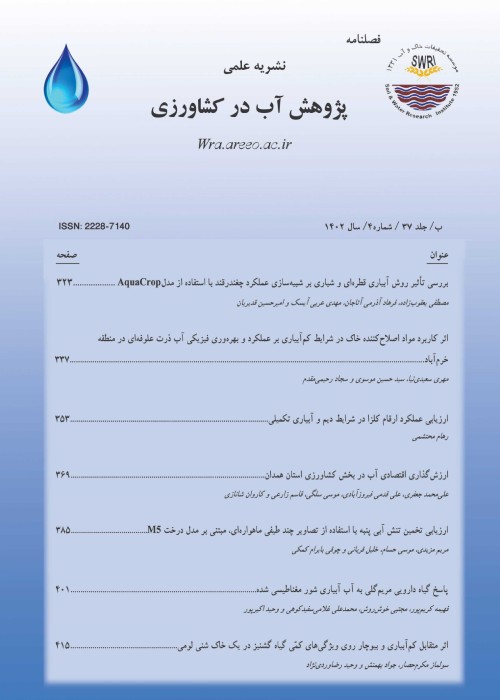Effect of Shallow and Saline groundwater on Rice Growth and Biomass
Author(s):
Article Type:
Research/Original Article (دارای رتبه معتبر)
Abstract:
]
The problem of soil salinity exists in the paddy field areas in Iran, especially in the Caspian Sea coastal areas, due to its proximity to the sea and low altitude with saline and shallow water table. Besides, considering that rice is one of the most important strategic crops for economy of Iran and the people in this area, this research was necessary in order to investigate the possibility of production of rice in the presence of shallow and saline groundwater table. This research was performed as a physical model (insulated metallic lysimeter) in the Meteorological Research Center of College of Agriculture and Natural Resources, University of Tehran, in 2017. The complete randomized design included two treatments with shallow water table: FSG and SSG, with fresh (control) and saline water, respectively. The salinity of irrigation water was 0.94 dS/m for both treatments. Moreover, for SSG treatment, the EC of shallow groundwater was 20 dS/m at 40 cm soil depth and was regulated as an artificial recharge. The results of salinity profile in SSG treatment showed that there was almost no mixing of fresh and saline water in interstitial zone (under the hard pan from 30 cm to 40 cm of soil surface). In this manner, there was insignificant effect of salinity in the root zone, because of existing of permanent water layer in rice field and downward water flow, which makes an obstacle for upward flow for saline water. This problem did not affect the rice yield, which didn’t decrease. The results of data analysis confirm this and show that shallow groundwater salinity has no significant effect on the parameters like leaf area index (LAI), root length (RL), plant length (PL), membrane stability index (MSI), chlorophyll (SPAD), relative water content (RWC) and the biomass (BIO). The difference between the performance of the control and the salinity treatments was about 1 to 12 percent, while the grain and biological yield in SSG treatment compared with FSG treatment decreased 3.2% and 4.5 percent, respectively. Therefore, considering the significant leaching of soil after cultivation, the negligible loss of yield and upward movement of saline water in the soil, production of rice and other plants in such areas seems possible. Also, with the help of efficient and effective use of lands with shallow saline groundwater, we can decrease the pressure on conventional soil and water resources.
The problem of soil salinity exists in the paddy field areas in Iran, especially in the Caspian Sea coastal areas, due to its proximity to the sea and low altitude with saline and shallow water table. Besides, considering that rice is one of the most important strategic crops for economy of Iran and the people in this area, this research was necessary in order to investigate the possibility of production of rice in the presence of shallow and saline groundwater table. This research was performed as a physical model (insulated metallic lysimeter) in the Meteorological Research Center of College of Agriculture and Natural Resources, University of Tehran, in 2017. The complete randomized design included two treatments with shallow water table: FSG and SSG, with fresh (control) and saline water, respectively. The salinity of irrigation water was 0.94 dS/m for both treatments. Moreover, for SSG treatment, the EC of shallow groundwater was 20 dS/m at 40 cm soil depth and was regulated as an artificial recharge. The results of salinity profile in SSG treatment showed that there was almost no mixing of fresh and saline water in interstitial zone (under the hard pan from 30 cm to 40 cm of soil surface). In this manner, there was insignificant effect of salinity in the root zone, because of existing of permanent water layer in rice field and downward water flow, which makes an obstacle for upward flow for saline water. This problem did not affect the rice yield, which didn’t decrease. The results of data analysis confirm this and show that shallow groundwater salinity has no significant effect on the parameters like leaf area index (LAI), root length (RL), plant length (PL), membrane stability index (MSI), chlorophyll (SPAD), relative water content (RWC) and the biomass (BIO). The difference between the performance of the control and the salinity treatments was about 1 to 12 percent, while the grain and biological yield in SSG treatment compared with FSG treatment decreased 3.2% and 4.5 percent, respectively. Therefore, considering the significant leaching of soil after cultivation, the negligible loss of yield and upward movement of saline water in the soil, production of rice and other plants in such areas seems possible. Also, with the help of efficient and effective use of lands with shallow saline groundwater, we can decrease the pressure on conventional soil and water resources.
Keywords:
Language:
Persian
Published:
Journal of Water Research in Agriculture, Volume:32 Issue: 4, 2019
Pages:
499 to 515
magiran.com/p1936764
دانلود و مطالعه متن این مقاله با یکی از روشهای زیر امکان پذیر است:
اشتراک شخصی
با عضویت و پرداخت آنلاین حق اشتراک یکساله به مبلغ 1,390,000ريال میتوانید 70 عنوان مطلب دانلود کنید!
اشتراک سازمانی
به کتابخانه دانشگاه یا محل کار خود پیشنهاد کنید تا اشتراک سازمانی این پایگاه را برای دسترسی نامحدود همه کاربران به متن مطالب تهیه نمایند!
توجه!
- حق عضویت دریافتی صرف حمایت از نشریات عضو و نگهداری، تکمیل و توسعه مگیران میشود.
- پرداخت حق اشتراک و دانلود مقالات اجازه بازنشر آن در سایر رسانههای چاپی و دیجیتال را به کاربر نمیدهد.
In order to view content subscription is required
Personal subscription
Subscribe magiran.com for 70 € euros via PayPal and download 70 articles during a year.
Organization subscription
Please contact us to subscribe your university or library for unlimited access!



